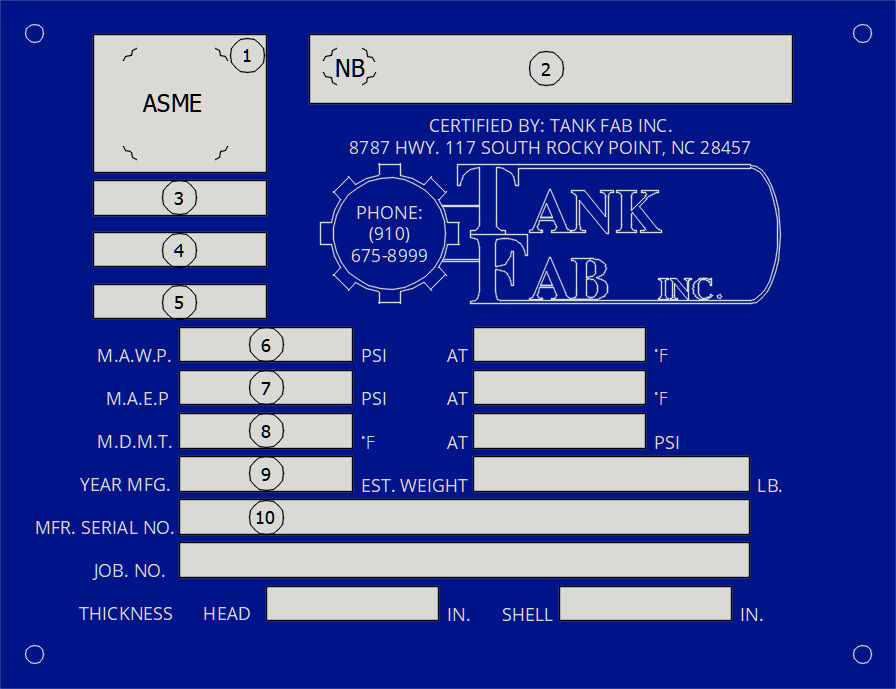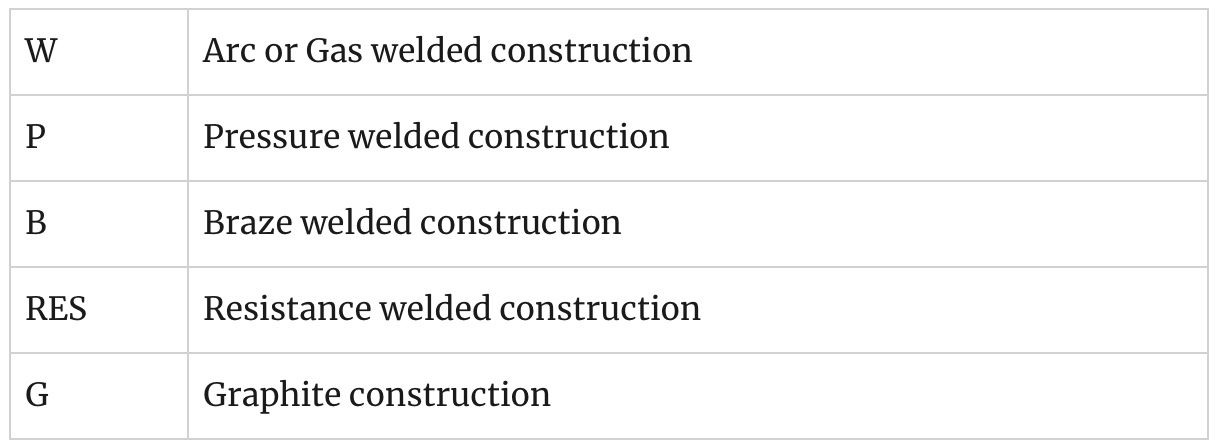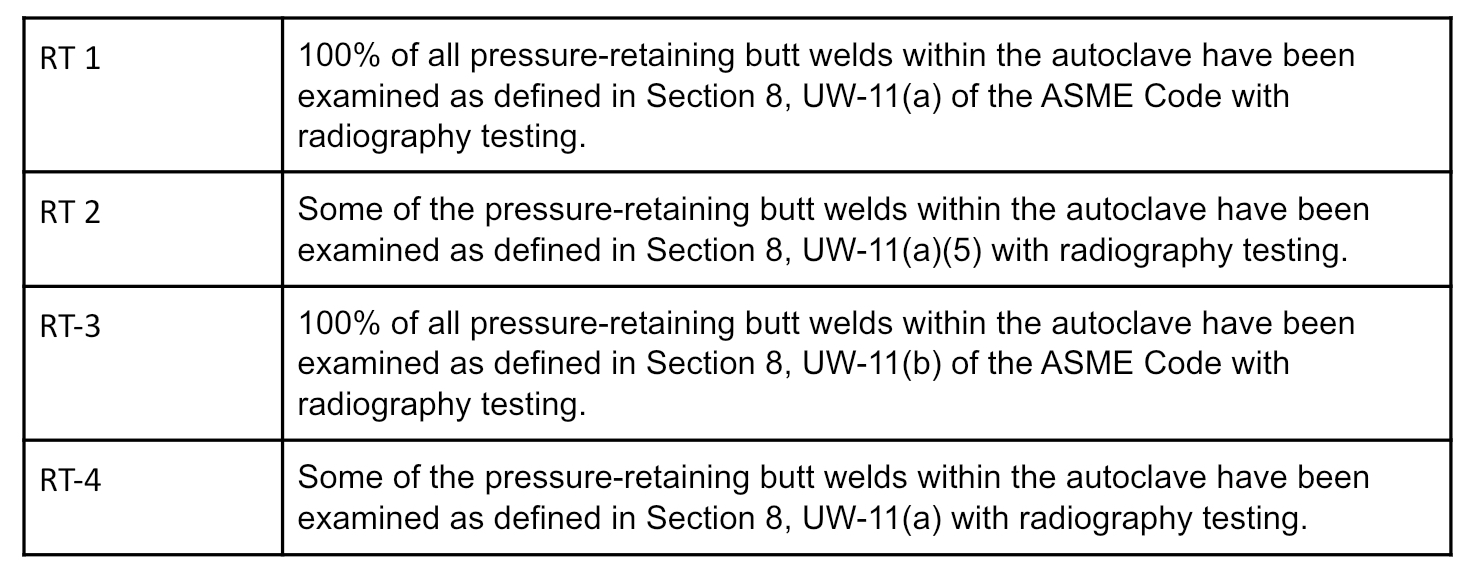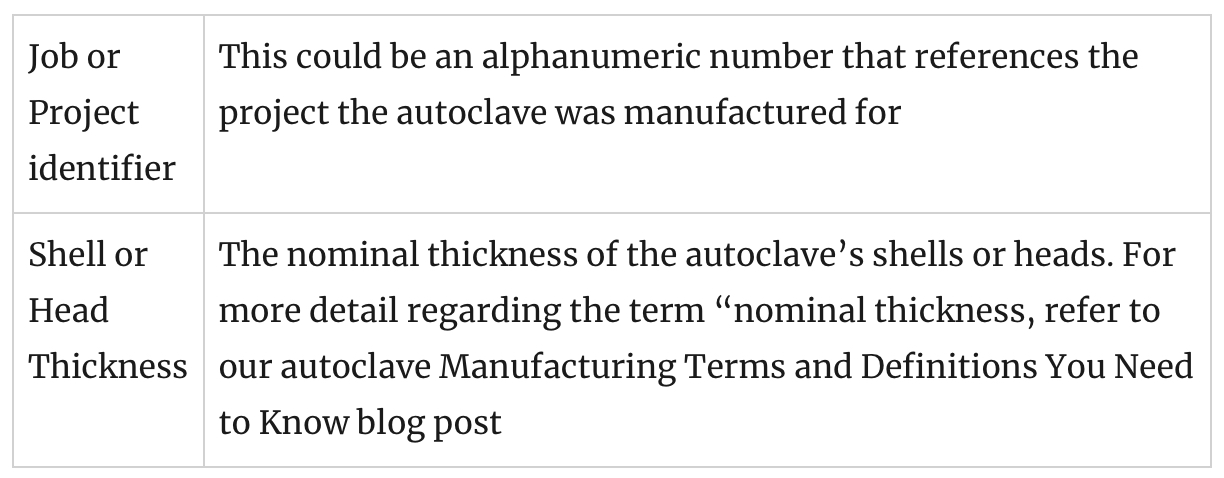Each new autoclave includes a nameplate.
Whether you pay much attention to it or not, the nameplate is one of the most important elements of your autoclave.
The autoclave nameplate is the proof that your vessel isn’t violating federal, state, and or local laws or regulations.
We’re going to get into the nitty-gritty of the autoclave nameplate, as well as why it matters so much. (Note: The numbers on the following list match up with the numbers in the picture below.)

Figure 1- ASME Code nameplate example
All the autoclaves we build at Tank Fab are manufactured in accordance with the ASME Code.
According to these requirements, the autoclave must include a nameplate. Once the vessel passes its final evaluation, the ASME Code mark is stamped onto the nameplate, proving the autoclave was built in line with this standard.
This spot on your autoclave nameplate is for the National Board number. If the autoclave manufacturer chooses to register the autoclave’s manufacturer’s data report with the National Board, a distinctive number is given to the vessel and it’s displayed in this spot.
This is good for you, as the autoclave owner. This document – coupled with the nameplate – proves your autoclave meets the requirements of the ASME Code to all federal, state, and local inspectors.
Lacking the data report and the nameplate, most regulators will not allow the autoclave to operate within their jurisdiction. But, If you happen to lose this document, you can get in touch with the National Board, and, for a small charge, obtain a copy of the manufacturer’s data report.
When you’re placing an order for the report, you’ll need to provide this information from the autoclave nameplate:
Keep in mind that it’s not required for an autoclave to be registered with the National Board. But, at Tank Fab, we feel like this is a significant advantage for all of our customers, so we register all of the autoclaves we manufacture.
This area of the autoclave nameplate is to identify the type of construction that was used to manufacture your autoclave. Here’s a list of the various identifiers that may be used.

If your autoclave is manufactured for special service use, as designated within the ASME Code, then an identifier is also displayed in this spot on the nameplate. This designation follows the identifiers listed above, preceded by a hyphen. The identifiers for the different special services are shown below.

For example, if your autoclave was manufactured with welded construction and for lethal service, the identifier would be displayed as “W-L”.
During the manufacturing phase of your autoclave, its welds may have been tested with radiography. If that’s the case, one of the following identifiers will be displayed in this spot on the nameplate.

Your autoclave may have been post-weld heat-treated during the manufacturing phase of construction.
If so, one of the following identifiers will be displayed in this area of the autoclave nameplate..
 6. Autoclave Maximum Allowable Working Pressure
6. Autoclave Maximum Allowable Working Pressure
This area of the autoclave nameplate is where you’ll find the autoclave’s maximum allowable working pressure and the maximum temperature.
It’s important to note that, if you plan to use the vessel at a pressure above the maximum temperature displayed here, it could lead to a monumental failure of the autoclave.
Keep in mind that this pressure is not the level you will work the vessel at during standard processes. (See the terms “Design Pressure” and “Maximum Allowable Working Pressure” in our 21 Autoclave Manufacturing Terms and Definitions You Need to Know blog post.)
This spot shows the autoclave’s maximum allowable external pressure (vacuum) and the maximum temperature.
If you plan to use the vessel at a pressure above the temperature displayed here, you may experience an autoclave disaster.
The minimum temperature that the autoclave was designed to operate at is shown here. Operating the autoclave below this temperature could also lead to a catastrophic failure.
If you intend to use the autoclave outside of the figures listed in areas 6, 7, or 8 as defined in this post, it’s highly recommended you talk with an engineer that is experienced with ASME Code.
If not, guess what could happen? Yes – failure. And not only of the equipment, but it could also create a fatal situation for your employees or anyone in the immediate vicinity.
This is the year your autoclave was manufactured. This information is especially important if you’re buying a used autoclave for use in your facility.
ASME Code requirements have changed significantly in the past two decades. Buying a used autoclave that was built more than 20 years ago may not meet today’s guidelines for your state or local jurisdiction.
Without fail, investigate what those requirements are before buying a used autoclave. Doing so will save you money and the hassle of getting rid of a multiple ton paperweight because it doesn’t meet today’s standards.
Every autoclave a manufacturer builds that meets the ASME Code requirements must be given a distinctive serial number. This is the spot where the serial number is shown.
Numbers 1 through 10, displayed in Figure 1, are required by the ASME Code to be displayed on an autoclave nameplate.
But, more information may be provided as a convenience for you. Some examples are:

Now that you understand what the information on your autoclave nameplate means, you need to know where the nameplate is located.
Unfortunately, the ASME Code does not specifically specify the location for an autoclave’s nameplate.
Here are a couple of places you can look:
Now that you understand the different components of your autoclave’s nameplate, you can see why it’s one of the most important parts of your autoclave’s assembly.
You can be sure that your vessel meets federal, state, and local regulations so that nothing gets in the way of efficiency and meeting your production and revenue goals.